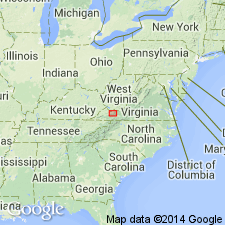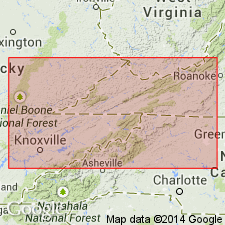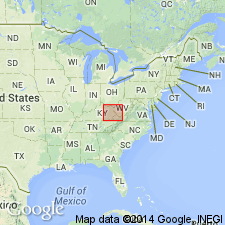
- Usage in publication:
-
- Gratton limestone
- Modifications:
-
- Named
- Dominant lithology:
-
- Limestone
- AAPG geologic province:
-
- Appalachian basin
Summary:
Named the Gratton limestone for Gratton, 5 miles east of Tazewell, Tazewell Co., VA. Consists of laminated limestone and calcilutite that ranges from 0 to 120 feet thick (averages 60 feet). The Gratton corresponds to the lower part of Butts' (1940) Lowville-Moccasin interval east of Tazewell. Unit overlies the Burkes Garden member of the Benbolt limestone, the Shannondale member of the Benbolt limestone, or the Cliffield formation, and underlies the Wardell formation. The Gratton is of Middle Ordovician age.
Source: GNU records (USGS DDS-6; Reston GNULEX).

- Usage in publication:
-
- Gratton limestone
- Modifications:
-
- Areal extent
- AAPG geologic province:
-
- Appalachian basin
Summary:
Pg. 1165-1166. Gratton limestone. Geographically extended into northeastern Tennessee. Formation thins toward southwest as underlying Benbolt limestone and overlying Wardell formation thicken. Between Tazewell and Sharps Chapel, the Gratton rests directly on dolomites of the Beekmantown and locally has thickness of several hundred feet. [Age is Middle Ordovician.]
Source: US geologic names lexicon (USGS Bull. 1200, p. 1581).

- Usage in publication:
-
- Gratton Limestone*
- Modifications:
-
- Overview
- AAPG geologic province:
-
- Appalachian basin
Summary:
The Gratton Limestone occurs in the subsurface of southwestern VA between the St. Clair and Pulaski thrust faults as shown in section G-G'. Overlies the Wardell Formation and underlies the Moccasin Formation. The Gratton is of Middle Ordovician (Mohawkian) age.
Source: GNU records (USGS DDS-6; Reston GNULEX).
For more information, please contact Nancy Stamm, Geologic Names Committee Secretary.
Asterisk (*) indicates published by U.S. Geological Survey authors.
"No current usage" (†) implies that a name has been abandoned or has fallen into disuse. Former usage and, if known, replacement name given in parentheses ( ).
Slash (/) indicates name conflicts with nomenclatural guidelines (CSN, 1933; ACSN, 1961, 1970; NACSN, 1983, 2005, 2021). May be explained within brackets ([ ]).

